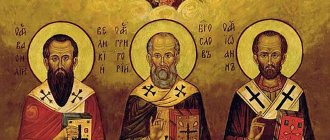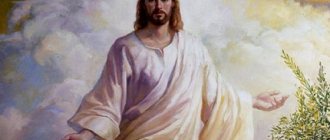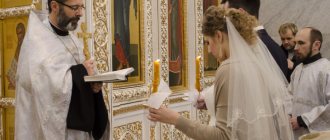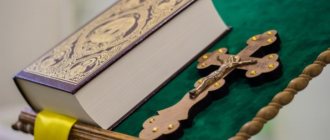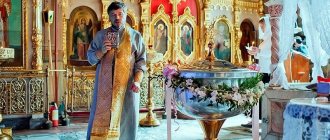Currently, more and more people are deciding to come to the temple of God. This is very good, because an increase in the number of people in the church indicates only one thing, the strengthening of the Orthodox faith.
Everyone who first comes to the temple does not know what and how to do. But don't worry, in time you will know everything
Many who have been going to church for a long time know everything and don’t need to explain anything to them. But those who are just starting to attend church do not know how to behave in church. The rules of behavior in the temple are quite simple.
Before entering the temple, you need to cross yourself three times with bows from the waist.
How to enter church correctly? And what should you say before entering the temple? When approaching the doors of the temple, you need to cross yourself three times and make a bow from the waist.
The photo shows how to cross yourself correctly and how to fold the fingers of your right hand.
When making the sign of the cross, you need to say the following words: “God cleanse me, a sinner, and have mercy on me.”
You need to make the sign of the cross with your right hand. But not only the entrance to the temple must be correct, but also in the temple itself one must behave appropriately.
Unbaptized people and women usually stand in the vestibule of the temple on critical days.
First, let's look at what church rule exists for those who have just come for the first time. After the doors of the temple, the believer goes into the so-called church, or rather into the vestibule of the temple.
How to behave in church? This place is considered to be the contact between the earth and the divine. Usually there is a candle shop here, where you can buy candles, submit notes of health and repose, and you can also order a prayer service or memorial service.
Usually unbaptized people and women during their periods stand in this place.
Then you can go to the temple itself. First you need to look around and see what people around you are doing.
See also the article Why things are getting bad in the church
You need to be baptized and bow in church together with everyone
Many people ask when to be baptized? During prayer, you need to stand with your head and shoulders slightly lowered. You can make the sign of the cross without bowing, or bow to the ground when others are doing it. The same applies to when it is better to be baptized.
If you do not know when to be baptized, then you can be baptized along with everyone present in the church
It is advisable to stand at the service from beginning to end. Many are also interested in whether the entire service needs to be standing? This question torments many. The service lasts no more than two hours; if you are young and healthy, it is best to stand.
The only exceptions are elderly and sick people. Of course, out of habit, it will seem difficult right away, but then several times during the service, for a couple of minutes, you can sit down.
Quite common questions that people ask are when can they go to church and on what days do they go to church? The answer here is simple.
You can come to the temple whenever you want.
There are no requirements or rules for this, but it is advisable to go to temple at least once a week.
But you should go there of your own free will, and not at the direction of someone. Many, for example, prefer to go to Sunday liturgy in the morning, or when there is a day off or a free day during the week.
Is it possible to go to church in the evening? The answer is yes, of course you can. Usually the evening liturgy begins at 17:00 or 18:00, but more accurate information should be found in the church.
The priest, Father Arkady, speaks very well about how to behave correctly in church:
These are basic recommendations on how to behave in church.
By leaving a comment, you accept the user agreement
First steps in the Orthodox Church: twelve facts you need to know
Orthodox worship is unusual! Some of its distinctive features are noticeable as soon as you cross the threshold of the temple, and can be confusing. Its other features become obvious over time. I will provide some background information that may help you feel more confident at an Orthodox service: twelve facts that you need to know when you find yourself in an Orthodox church for the first time.
1. What kind of mess is this?
At the very beginning of the service, you may get the impression that there is confusion in the church: people go to the front of the church, pray in front of the iconostasis (a row of icons standing in front of the altar), kiss various objects, light candles, despite the fact that the service is already in progress. In general, when you entered, the service was already in progress, although it was clearly written on the door: “The Divine Liturgy begins at 9:30.” You were clearly embarrassed that you were late, but these people arrived even later and are now moving around the temple. What's going on here?
On Sundays in the Orthodox Church there is one Eucharistic service* - the Divine Liturgy, preceded by Matins [in the Greek and Slavic Churches the liturgy is served after Matins - ed.].
There is no break between these services; as soon as one ends, another begins, so the start time of the service is indicated tentatively. In total, during a Sunday service, the clergyman spends more than three hours in the altar, “being in the light,” as one priest put it. Because everyone is constantly on the move, there is never a moment when everyone is sitting in the pews, meekly waiting for the opening verse to begin and watching the hands of the clock approach 9:30. Orthodox believers can arrive at different times of Matins or the beginning of the Liturgy, that is, somewhere within the hour. Whenever they arrive, the service is probably already underway, but this does not prevent them from performing the personal prayers required upon arrival at the temple.
This is distracting for newcomers and can even be perceived as disrespectful, but you soon begin to understand that this is not just a formality, but a deeply personal expression of faith. Of course, this does not justify those who are late, but, unfortunately, punctuality is often absent from the list of virtues of many Orthodox believers.
2. Stand for Christ!
In the Orthodox tradition, believers stand for almost the entire service. Indeed. Some Orthodox churches don't even have chairs, except for a few around the edges of the room for those who need them.
In any case, if you find it too difficult to stand all the time, you can sit down. No one will object, and hardly anyone will pay attention to it. Over time, you will get used to standing for long periods of time.
3. Sim win
It is no exaggeration to say that we are often baptized. We make the sign of the cross at the mention of the Holy Trinity, when we venerate the cross or an icon, and many more times during the Divine Liturgy.
But this does not mean that everyone should behave the same.
Some cross themselves three times in a row, others, having crossed themselves, touch the ground with their right hand. Upon entering the temple, some believers can approach the icon and perform “throwing” - cross themselves, touch the floor with their right hand, and, having done this twice, kiss the icon, and then repeat “throwing” again.
Over time it won't be difficult, but at first it seems like it's only for the initiated and you're afraid of doing something wrong. Rest assured, you don't have to follow their lead immediately.
We cross ourselves with our right hand from right to left, unlike Catholics and Protestants - High Church Anglicans. We fold our fingers in a special way: the thumb and the next two are joined together, and the remaining two fingers are pressed against the palm.
As with all our actions, with this Orthodoxy encourages us to confess our faith. Try to guess what symbol is behind this? (Three fingers folded together symbolize the Trinity, two fingers lowered to the palm - the two natures of Christ, as well as His descent to earth).
This also requires training. But if at first you do not put your fingers together accurately, no one will accuse you of heresy.
4. Kneeling
As a rule, we do not pray on our knees. Sometimes we fall on our faces. But not in the same way as Catholics fall prostrate on the floor. We kneel, rest our hands on the floor and touch it with our foreheads.
It looks like in photographs from some Central Asian worship service, and to representatives of Western culture it seems unprecedented.
At first you feel awkward, falling on your face, but everyone else does it naturally and eventually the awkwardness goes away. Women notice that it is more convenient to bow to earth in wide skirts, and it is more comfortable to stand in shoes without heels. Sometimes we bow to the ground and immediately rise, as during the prayer of St. Ephraim the Syrian, which is often recited during Lent. It happens that we worship and linger for a while, as they do in some communities in some places of the Eucharistic Prayer.
Not everyone prostrates. Some believers kneel, others stand with their heads bowed, and those seated may lean forward and sit hunched over. Standing timidly is also not forbidden. Nobody will pay attention if you don't fall on your face. For Orthodoxy, various forms of expressing personal religiosity are more characteristic than the feeling that you are being watched and may be offended if you do something wrong.
One of the former priests of the Anglican Church in America admitted that his decision to become Orthodox was most influenced by the sight of believers bowing to the ground. He thought then that this is how he should stand before God.
5. I love you and kiss you.
We kiss the shrines.
When we enter a church, we kiss the icons (it is customary for Jesus to kiss the feet, and for saints the right hand). You soon notice that some kiss the Holy Chalice, some kiss the hem of the priest's vestments when he comes by, the clerics kiss his hand when they hand him the censer, at the end of the service we all line up to kiss the cross.
When we say that we “kissed” something, it means that we made the sign of the cross and kissed this object.
Before communion we kiss each other (“Greet one another with the kiss of love (1 Peter 5:14) (today in Russia the kiss of peace is preserved among the clergy - editor’s note). When Catholics and Protestants of the High Church perform the “teaching of peace", they hugging, shaking hands, or lightly touching each other's cheeks - this is a common greeting from representatives of Western culture. The Orthodox have a different culture: Greeks and Arabs kiss on both cheeks, Slavs - three times. Give in to the initiative of those nearby, and try not to bump noses.
To a typical appeal: “Christ is in our midst,” they answer: “He is and will be.” Don't be afraid if you forget what to answer. Here they do not say the usual Protestant greeting: “The peace of the Lord be with you,” and it would also be inappropriate to say something like: “What a wonderful church you have.” Kissing peace is a liturgical action, a sign of mystical unity. Leave conversations and communication for later.
6. Blessed and sacrificial bread
Only Orthodox Christians can take communion, but everyone can eat particles of the consecrated bread.
It happens like this: one of the parishioners bakes round bread for communion and an imprint is made on it with a seal.
During the preparatory service before the liturgy, the priest cuts out a segment from the seal and sets it aside. It's called "Lamb". The remaining portion of the bread is cut into pieces, placed in a large basket and blessed by the priest. During the Eucharistic Prayer, the Lamb is transformed into the Body of Christ, and the wine in the Chalice is transformed into His Blood. And then something amazing happens: the priest lowers the Lamb into the Chalice of Wine. When we receive communion, we approach the priest one after another, opening our mouths wide, and he gives us a piece of bread soaked in wine from a golden spoon. He also reads a prayer over us, calling our name or the name of the saint that we received at baptism or confirmation (the sacrament of acceptance into the Church through anointing with sacred oil).
Having passed the priest, we approach the altar boy, who is holding a basket of consecrated bread. People take pieces for themselves or their non-Orthodox friends. If someone treats you with a piece of consecrated bread, do not be alarmed - this is not communion. This is a symbol of brotherhood.
Casual visitors are sometimes offended that they are not allowed to take communion. In Orthodoxy, it is believed that Communion is broader than a personal relationship with Christ. It certifies belief in historical Orthodox doctrine, submission to a particular Orthodox bishop, and allegiance to a particular Orthodox community. There are no privileges here; anyone can become faithful to the Orthodox Church. But the Eucharist is the treasure of the Church, and it is reserved for those who have connected themselves with the Church. This is similar to postponing marital relations until marriage.
Another reason why we protect the Eucharist from public access is that we take it more seriously than many other Christian denominations. We believe that this is truly the Body and Blood of Christ. We do not begin communion without confessing our sins to the priest and making peace with other members of the Church. We abstain from food and drink, even our morning cup of coffee, from midnight before communion.
So, we come to the topic of the post. When newcomers learn about this Orthodox tradition, they usually have a hard time believing it. We abstain from meat, fish, dairy, wine and vegetable oil every Wednesday and Friday, as well as during four periods of the year, the longest during Lent before Easter. In total it takes about six months.
Here, as elsewhere, variations are possible. After consulting with the priest, people decide to what extent they can maintain these fasts, both from a physical and spiritual point of view - excessive strictness can soon lead to frustration and depression. Fasting is a personal matter for each person. As St. said John Chrysostom in his Easter sermon, this is a holiday for everyone who fasted and who did not: “temperate and careless, honor this day alike; you who have fasted and those who have not fasted, rejoice now!”
It is important to note that fasting is not a strict rule, breaking which puts you in terrible danger, and it is not a punishment for sins. Fasting is an exercise for our growth and strengthening, a medicine for the soul.
After consulting with a priest, as a spiritual doctor, you can develop a measure of fasting that will keep you in good shape, but will not break you.
Perhaps next year you will be able to handle more. Over time, after experiencing fraternal fasting with a loving community, many people find that they begin to enjoy fasting. 7. Why is there no general confession?
We believe that we do not have the same sins, they are all individual. There is no separate prayer of confession during the liturgy. Orthodox Christians must regularly confess to a priest in person.
The role of the priest is more reminiscent of the role of a spiritual father than in other faiths. They do not simply address him by name, but pronounce him “father” before the name. His wife also has her own specific role as the mother of the parish, and she is also called by a special name, depending on the culture: in Arabic “Khouria”, in Greek “Presbytera”, both of which mean the priest’s wife, and in Russian “ matushka" which means "mother".
Another feature is the Creed, which is recited or sung, depending on the parish. If you say out of habit or intentionally, “And from the Son who proceedeth,” no one will support you. The Filioque appeared in the Creed six centuries after its composition, and we adhere to the original version. Visitors from High Church communities note that we do not bow or kneel at the words “and he who became incarnate.”
We also do not stop exclaiming “Hallelujah” during Great Lent, as the nuns of the Anglican Communion do; moreover, Lenten Matins are especially replete with this exclamation.
8. Music.
About seventy-five percent of the service is occupied by parishioners singing. Orthodox Christians do not use musical instruments during services. The singing is usually led by a small a cappella choir, and the degree to which parishioners participate in the singing varies from parish to parish. The musical style also varies, ranging from single-voice singing in the eastern traditions of the Arab Church to the European sound of four-part harmony in the Russian Church, with many variations in between.
This continuous singing is overwhelming at first, it seems as if you are stepping onto a rapidly moving escalator, and you are carried for an hour and a half until you get off it. Someone rightly noted that the liturgy is one continuous song.
Almost the same thing is sung every week, and this prevents fatigue. Each subsequent Sunday the service changes very slightly, the main prayers and chants are in the same order, and soon you will already know them by heart. Then you will begin to feel the presence of God, which is almost impossible to do at that stage when you switch, now to reading the prayer book, now to the text of the liturgy, now to studying the parish leaflet.
9. Editors are powerless
Isn't it possible to say this more briefly? Why these extra epithets? Is it possible to once again condense this text, even if it is quite accurate and apt? But then it will no longer be an Orthodox service. Orthodox Christians will always try to express themselves as broadly as possible. In the Orthodox faith, there is never too much prayer, and this also applies to its other aspects. When a priest or deacon exclaims: “Let us fulfill our ** prayer to the Lord...”, be sure that you will have to stand for another fifteen minutes.
Initially, the liturgy lasted more than five hours, this shows that people in those days were on fire with their hearts for the Lord. St. Basil the Great, in his edition of the liturgy, reduced its duration to two and a half hours, and later (about 400) St. John Chrysostom further reduced this time to one and a half hours. Usually on Sundays the Liturgy of St. John Chrysostom, but on some days (Sundays of Great Lent, Epiphany Eve), we serve a longer liturgy of St. Basil the Great.
10. Chosen Voivode
An invariable feature of Orthodox worship is the veneration of the Virgin Mary, the “Invincible Leader” of all Christians. We also call her the Theotokos or Mother of God. She contributed to our salvation by making the incarnation of God into man physically possible. But, despite Her veneration, as it is said in the Gospel: “Behold, from now on all generations will bless Me” (Luke 1:48), this does not mean that we believe in the magical powers of Her or other saints or consider them demigods. When we sing “Most Holy Theotokos, save us,” we do not expect that She will grant us salvation in eternity, but we ask Her prayers for our intercession and growth in faith.
We ask for the prayers of the Virgin Mary and other saints just as we ask for the prayers of each other.
They didn’t die, they simply went to another world. We surround ourselves with icons to remind us that all saints participate invisibly in our prayer. 11. Three gates.
In every Orthodox church there is an iconostasis in front of the altar. Iconostasis means “stand for icons” and it can simply represent a large icon of Christ on the right and an icon of the Virgin and Child on the left. In a more well-equipped church, the altar may be a partition decorated with icons. Some types of iconostases block the altar from view, except for those moments when the central gate is open.
The simplest version of the iconostasis with two large icons has three entrances.
The central one, directly in front of the altar, is called the Holy or Royal Doors, because during the Eucharist the King of Glory himself comes out to the worshipers through them. The Holy Gates are used only by a priest or deacon with the Chalice in his hands. On both sides of the icons, if this is a simplified iconostasis, there are doors with angels depicted on them; they are called the Deacon's Gate. They are used by altar servers and other ministers, but it is not allowed to enter or leave the altar unless absolutely necessary. Altar servers - priests, deacons, altar servers - can only be male. Women can participate in all other areas of church life. Women's contributions have been valued on an equal basis with men's since the time of the first martyrs; looking towards the altar, you can always see the Mother of God and other holy women. In many Orthodox churches, women work equally with men: they direct the choir, paint icons, teach lessons, read the Apostle and participate in the parish council.
12. Where should an American go?
Flipping through the Yellow Pages of any metropolis, you can find a large number of Orthodox churches: Greek, Romanian, Russian, Antiochian, Serbian and many others. Is Orthodoxy really that nationally oriented? Are these divisions evidence of theological divisions and schisms? Not at all. All these Orthodox churches are one Church. Nationality indicates under whose jurisdiction the parish falls and to which bishop it reports.
With 6 million Orthodox Christians in North America and 250 million worldwide, the Orthodox community is the second largest of all Christians.
Despite such national diversity, it is striking that Orthodoxy is united on theological and moral issues. Orthodox Christians throughout the world unanimously adhere to the fundamental Christian principles preached by the apostles, which are passed down from generation to generation by bishops - the apostolic successors. In addition, they are faithful to the apostolic principles of morality: abortion and sexual relations outside the family are also considered sins from the Orthodox point of view.
Some might explain this unity as a historical accident. However, we attribute this to the influence of the Holy Spirit.
Why then such a variety of national churches? This nationality clearly reflects geographical features. North America is also a geographical entity; someday we will also have one national church: the American Orthodox Church. This should have been the case initially, but due to complex historical background this did not happen. Instead, each Orthodox ethnic group that emigrated to the United States produced its own church structure. This diversity of Orthodox jurisdictions is nothing more than a temporary misunderstanding; intense prayers and a lot of work are being done to overcome these unnecessary barriers.
Currently, the largest jurisdictions in America are the Greek Orthodox Metropolis, the Orthodox Church in America (Russian origin) and the Antiochian Metropolis (Arab origin). The liturgies in all of them are basically the same, perhaps with some differences in language and music.
At first, Orthodoxy strikes you with its unusualness, but over time this feeling passes. More and more you begin to feel at home in it, and gradually it will lead you to your true home - to the Kingdom of Heaven.
Translated from English especially for the portal “Orthodoxy and Peace” by Marina Leontyeva


